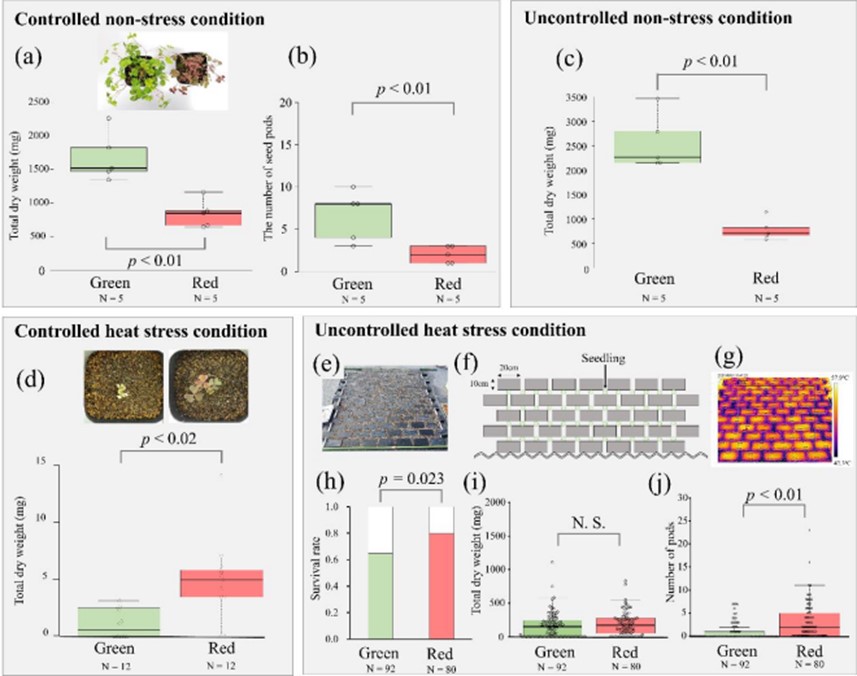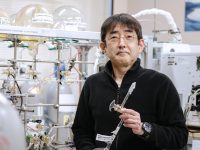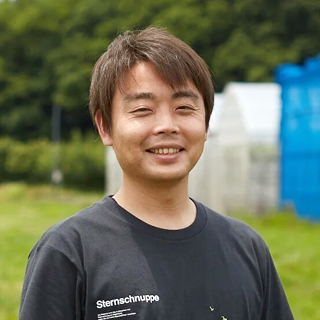Researchers from Japan uncover how urbanization impacts plant evolution and stress adaptation in the creeping woodsorrel plant.
Urban environments have become hotspots for understanding how rapid evolution occurs in response to extreme environmental changes. These habitats exert selective pressures on resident organisms that impact their evolutionary trajectories. Recently, researchers from Japan investigated how the creeping woodsorrel plant might adapt in response to elevated temperatures that result from urbanization. Understanding these effects can help predict evolutionary traits to manage plant evolution in the face of shifting climatic conditions.

Image title: Role of heat stress on leaf color evolution in Oxalis corniculata
Image caption: A recent study examined the role of heat stress over the growth and survival of green and red Oxalis corniculata variants in controlled and uncontrolled cultivation setups. This figure depicts a comparison of various parameters between green- and red-leaved variants of O. corniculata under different cultivation conditions.
Image credit: Yuya Fukano from Chiba University
Image license: CC BY 4.0
Urbanization and human activities have transformed a significant proportion of the land on Earth, resulting in the formation of urban environments. These urban environments are man-made habitats that often impose several selective pressures on their inhabitants. A key characteristic of such environments is the presence of impermeable, heat-retaining surfaces created using brick, stone, asphalt, and concrete. Notably, these surfaces form urban heat islands, i.e., regions with elevated surface temperatures. An unexpected result of heat stress is the impact on the behavior, physiology, and evolutionary trajectories of resident organisms. Although several studies have investigated the role of urban heat stress on evolution in animals, its effects on plant evolution remain largely unexplored.
To address this gap, a team of researchers led by Associate Professor Yuya Fukano from the Graduate School of Horticulture, Chiba University, Japan, investigated how urban heat islands affect the leaf colors of Oxalis corniculata, also known as the creeping woodsorrel. This plant exhibits diverse leaf colors ranging from green to red and is found in both urban and non-urban spaces across the world. Research suggests that these color variations serve as an evolutionary adaptation to protect the plant from environmental stress. Moreover, red pigments (anthocyanins) in the leaves are thought to mitigate heat and light-induced damage by intercepting light and forming antioxidants.
To investigate this evolutionary theory, Dr. Yuya Fukano and his team, comprising Dr. Wataru Yamori from the University of Tokyo, Dr. Yuuya Tachiki from Tokyo Metropolitan University, and Dr. Kenta Shirasawa from the Kazusa DNA Research Institute, conducted field observations of the leaf color distribution in the creeping woodsorrel, across urban and non-urban regions at the local, landscape, and the global scales. Their study findings were published in Science Advances on October 20, 2023. “We noticed that the red-leaved variants of the creeping woodsorrel commonly grew near impervious surfaces in urban areas but rarely grew in farmlands or green spaces in and around the city,” says Dr. Fukano, while discussing their observations. The team identified a pattern where green-leaved variants of the creeping woodsorrel dominated green spaces while their red-leaf counterparts dominated the urban sites of Tokyo at both the local and landscape levels. Upon further examination of an online database, the team discovered that these geographical findings were consistent across the globe, thereby confirming a link between urbanization and leaf color variations in the creeping woodsorrel.
This motivated the team to quantify the adaptive benefits of these leaf color variations by examining their influence over biomass growth and photosynthetic ability under heat stress and non-heat stress conditions across controlled and uncontrolled cultivation experiments.
Through these experiments, the team found that the red-leaf variants exhibited superior growth rates and higher photosynthetic efficiency under high temperatures, whereas green-leaf variants thrived in lower temperatures. As a result, red-leaf variants tend to thrive in urban areas with low plant density due to high stress tolerance. The opposite is true for their green-leaf counterparts, which display higher growth competitiveness in lush green areas. “Although these findings will not change much in the immediate future, this study showcases one of the most popular examples of ongoing evolution that can be observed in urban areas,” remarks Dr. Fukano.
The team also conducted genome-wide genetic analyses, which indicated that the red-leaf variant of O. corniculata may have evolved multiple times from the ancestral green-leaf plant. Discussing the implications of these findings, Dr. Fukano mentions, “Urban heat islands are precursors to global warming. Understanding the rapid adaptive evolution of urban organisms to high temperatures will provide valuable insights on ecosystem dynamics and sustainable crop production.”
These adaptations to high-temperature stress likely extend beyond leaf color, thereby warranting further research into various plant traits for a comprehensive understanding of plant adaptation to urban heat islands.
About Professor Yuya Fukano
Dr. Yuya Fukano is an Associate Professor at the Graduate School of Horticulture at Chiba University. He received his Ph. D from the Graduate School of Systems Life Science at Kyushu University. He has over 50 research publications to his credit and has previously served as an Assistant Professor at the University of Tokyo’s Institute for Sustainable Agro-ecosystem Services. Dr. Fukano specializes in ecology and crop science, focusing on sustainable agriculture that harmonizes environmental factors like climate change and biodiversity with food production. His field-based research encompasses crop production, evolutionary ecology, and conservation, and he also engages in sustainable smart agriculture using artificial intelligence technologies.
Reference
Title: From green to red: Urban heat stress drives leaf color evolution
Authors: Yuya Fukano1, Wataru Yamori2, Hayata Misu2, Mitsuhiko P. Sato3, Kenta Shirasawa3, Yuuya Tachiki4, Kei Uchida2
Affiliations:
- Graduate School of Horticulture Sciences, Chiba University, Chiba, Japan.
- Graduate School of Agricultural and Life Sciences, The University of Tokyo, Tokyo, Japan.
- Department of Frontier Research and Development, Kazusa DNA Research Institute, Chiba, Japan.
- Department of Biological Sciences, Tokyo Metropolitan University, Tokyo, Japan.
Journal: Science Advances
DOI: 10.1126/sciadv.abq3542
Contact: Yuya Fukano
Graduate School of Horticulture, Chiba University
Email: fukano@chiba-u.jp
Public Relations Office, Chiba University
Address: 1-33 Yayoi, Inage, Chiba 263-8522 JAPAN
Email: koho-press@chiba-u.jp
Tel: +81-43-290-2018
Recommend
-

Harnessing CO2 with a Photocatalyst for Fuel and Plastic Feedstocks: Advancing a Sustainable Society with Chemistry
2023.06.22
-

The World of Mold around Us: The A to Z of Mold
2023.04.06
-

Bringing Japan’s renowned experiment-based science education to Southeast Asia: Developing sustainable physics teaching materials for the pursuit of a disparity-free society
2023.11.24


